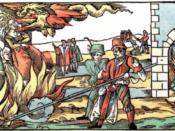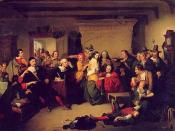Heresy and Witchcraft in Medieval Europe
Cormac Griffin
Major Essay Semester 2:
To what extent do you agree with Barstow that the witch craze resulted from early modern men's "loathing of women"?
Introduction
This essay will outline the main reasons that persuaded European communities to accuse and punish women for witchcraft in the seventeenth and eighteenth centuries. These reasons produced numerous trials of women for witchcraft throughout Europe. This essay will further aim to prove that Anne Barstow was accurate in here assertion that the witch craze was a result of early modern man's 'loathing of women'. During the Witchcraze this essay will assert that those at the bottom of the social ladder namely women were the ones being accused due to "anxiety over change, religious wars and changing values and attitudes about neighbourly responsibility and community"�.
Overview of a typical witch
The stereotypical witch is an independent adult woman who does not conform to the male notion of proper female behaviour.
She is assertive, she does not require love, and she does not nurture men or children, nor care for the weak. She has the power of words - to defend herself, or to curse. In addition, she may have other, more mysterious powers which do not derive from the established order. All women threaten make hegemony with their exclusive power to give life; and social order depended on women conforming to male ideals of female behaviour. Thus, the identification of any woman as a witch will, therefore, set against her not only males, but also conforming females and their children�.
There a many, many reasons why a person may be accused. Those with incurable diseases or infirmities were suspected. Especially those with leprosy or epilepsy, because they believed that these diseases are caused by witches. If you were...


